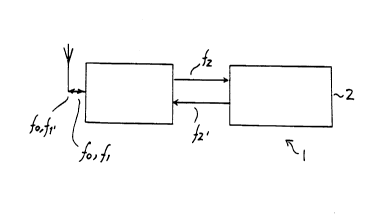Note: Descriptions are shown in the official language in which they were submitted.
W O 94/03982 2 ~ A ~ 8 7 1. PC~r/N 093/00103
IDENTIFICATION DEVICE.
The present invention concerns a method for individual idçntific~tion using
electronic int~llùgalion, and an identific~tion chip for this purpose, according to the
introductory part of patent claim 1, resp. 2.
The invention is based upon an idçntifi~tion chip having an inactive code carrier,
S which typically compricPs a so-called SAW (Surface Acoustic Wave) - col"pollent.
Such SAW-cclllpollents are well known for individual idçntifi~ti~n. The SAW-
cclllponent is coded, so that each chip has its own code, which gives a unique
itlçntific~tion of the chip, and the object to which it is f~ctenPd In ~ ition, each
chip contains an ~ntPnn~, and optionally col"ponenls for i.,.~l~nce m~tt~hing and
10 physical enr~psul~tion.
The use of such in-içntific~tic)n chips is based upon a central unit compricing a
tr~ncmittP and a receiver, ge~ g a microwave signal, which is tr~ncmittPA and
received by the ~nlPnll~ on the idçntific~tion chip. The signal is then converted to an
acoustic surface wave, which propagates along the SAW-col,lponent, and g*es
15 reflectionc, ~ luling the code of this cc",ponent. These reflçctPA signals are then
converted to an electronic signal. This signal is tr~ncmittçd from the chip and is
received by the receiver in the central unit, where it is further p~ocessed for
dermining the individual idçntifi~tion.
There are many dirr~,ei t embo-limPntc of these co",ponents in respect of code
20 m~th~lc, code length, physical geometry, choice of m~tçri~l, etc. Furthermore, it is
also known to use so-called BAW (Bulk Acoustic Wave) - co",pone"L~ for similar
purposes.
A disadvantage with SAW-chips is that they are relatively narrow-b~nded, so thateach kind of chip must be manufactured with a special geometry. This makes it more
25 difficult to provide efficient utili7~tion of frequencies above 1 GHz.
It is therefore an object of the present invention to provide a method and a device
for individual identification using electronic illl~.~ugation of the above mentioned
kind which permits a more flexible use of frequenciçs
The object of the invention is achieved with a method having rea~ures as stated in
30 the chara -tçri7ing part of patent claim 1 and an identification chip for use in
connection with the invention is stated in the char~ct~ri7ing part of patent claim 2.
Further fealules in the device are stated in the dependent claims.
W O 94/03982 - ` ~ Z~40~1. PC~r/N 093/00103
In the following, a prcrcllcd embodiment of the invention will be described withreference to the accol-lpanying drawings, in which:
Fig. 1 is a block diagram of a device for use according to present invention,
Fig. 2a and 2b are frequency diagrams for signals tr~ncmitt~d from the
5 tr~ncmitter/receiver unit,
Fig. 3a and 3b are frequency diagrams for refl~cted, coded signal, and
Fig. 4 is a more det~iled drawing of the col."~onents which are parts in a device
according to present invention.
Fig. 1 shows an identification chip according to present invention. The identifica-
10 tion chip is generally denoted 1, and comprises a code carrier 2, e.g. a SAW-com-
ponent, a frequency mixer 3, and an antenna 4. Signals from a tr~ncmittPr (not
shown) are received by the ~ntenna 4 and are propagated via the mixer 3, to the code
carrier 2. From the code carrier 2 a signal is reflected via the mixer 3 and trans-
mitted to the ~ t~llnA 4, and back to tr~ncmitterlreceiver unit (not shown).
15 Fig. 2a is a frequency diagram illustrating the signal which is tr~ncmitted from the
tr~ncmitt~r. In this example of an embodiment, an intcllogation signal f, is trans-
mitted together with a carrier signal fO. This signal is received by the ~ntenn~ 4 in
the identifc~tion chip 1. In the mixer 3, a mixed signal f2, shown in Fig. 2b, is
eYtraçted and taken to the code carrier 2. The signal f2 preferably has a frequency
20 which is the frequency dirrclcnce of the signals fi and fO.
Fig. 3a shows the refle~ted signal f2. from the code carrier 2. This signal f2 has
superimposed thereon the indiviual code carrier 2. Signal f2. is then again mixed, so
that an identification coded mixing signal denoted f, is formed, as shown in Fig. 3b.
As a result the tr~ncmitted and received signals fO, fi; fO, fl., have a much higher fre-
25 quency than the signals f2; f2 which are used internally in the indentific~tion chip 1.
In Fig. 4 is shown a specific embodiment of present invention. An identificationchip 1 comprises a SAW-colll~Jonent 2 of per se known kind. The ~ntenn~ 4 is an
aperture-connected microstrip ~ntenn~ Furthermore, the mixer 3 from Fig. 1
comprises a diode 5. The antenna 4 is connected to a tr~ncducçr 7 via an impedence
30 match 6. The tr~ncducer 7 converts the electronic signal to and from a surface
acoustic wave. The antenna 4 receives signals with frequencies fi and fO. These
signals are mixed by a diode 5, so that a mixed difference signal is transferred to the
WO 94/03982 i~l40871. PCI/NO93/00103
tr~nsducer 7 and is converted to a surface acuostic wave for the code carrier 2.In a further embodiment the mixing signal can come from a frequency source
which is internal of the identification chip.
It is also possible to use this technology with other kinds of code carriers, such as
S BAW (Bulk Acoustic Wave).
The mixer 3 may constitute more than one diode, or be acheived in other ways
which are known to the person skilled in the art.
